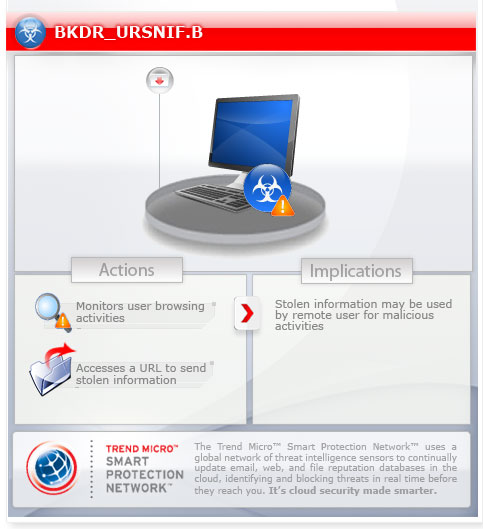BKDR_URSNIF.B
Windows 2000, Windows XP, Windows Server 2003


Threat Type: Backdoor
Destructiveness: No
Encrypted:
In the wild: Yes
OVERVIEW
This backdoor figures in a fraud campaign planned to hit various US-based banks. The capabilities of this backdoor are broadly similar to other banking malware such as ZeuS, SpyEye, and Gozi.
To get a one-glance comprehensive view of the behavior of this Backdoor, refer to the Threat Diagram shown below.

This backdoor arrives on a system as a file dropped by other malware or as a file downloaded unknowingly by users when visiting malicious sites.
It connects to a website to send and receive information.
TECHNICAL DETAILS
Arrival Details
This backdoor arrives on a system as a file dropped by other malware or as a file downloaded unknowingly by users when visiting malicious sites.
Installation
This backdoor drops the following copies of itself into the affected system:
- %User Profile%\nah_{random}.exe
(Note: %User Profile% is the current user's profile folder, which is usually C:\Windows\Profiles\{user name} on Windows 98 and ME, C:\WINNT\Profiles\{user name} on Windows NT, and C:\Documents and Settings\{user name} on Windows 2000, XP, and Server 2003.)
It injects itself into the following processes running in the affected system's memory:
- avp
- csrss.exe
- lsass.exe
- services.exe
- smss.exe
- winlogon.exe
- explorer.exe
Autostart Technique
This backdoor adds the following registry entries to enable its automatic execution at every system startup:
HKEY_CURRENT_USER\SOFTWARE\Microsoft\
Windows\CurrentVersion\Run
nah_Shell = "%UserProfile%\nah_{random}.exe"
Backdoor Routine
This backdoor connects to the following websites to send and receive information:
- {BLOCKED}.{BLOCKED}9.23.2
- {BLOCKED}.{BLOCKED}1.113.106
NOTES:
It monitors the user's browsing activities and gathers information if it contains the following strings:
- trade
- schwab
- fidelity
- paypal
- wamu
- bank
- wellsfargo
- suntrust
- usaa
- wachovia
It is capable of the following backdoor commands:
- Delete self
- Download Files
- Update self
- Shutdown
- Change Version
- Change Host
- change reserved IP
- Enable backdoor
- Send Cookies
- Receive Ccookies
- Enable Remote Desktop
- Execute files
It connects to the site http://{BLOCKED}ice.stat/ to send the following information:
- Operating system version
- Service pack version
- Network settings
SOLUTION
Step 1
For Windows XP and Windows Server 2003 users, before doing any scans, please make sure you disable System Restore to allow full scanning of your computer.
Step 2
Scan your computer with your Trend Micro product and note files detected as BKDR_URSNIF.B
Step 3
Restart in Safe Mode
Step 4
Delete this registry value
Important: Editing the Windows Registry incorrectly can lead to irreversible system malfunction. Please do this step only if you know how or you can ask assistance from your system administrator. Else, check this Microsoft article first before modifying your computer's registry.
- In HKEY_CURRENT_USER\SOFTWARE\Microsoft\Windows\CurrentVersion\Run
- nah_Shell = %UserProfile%\nah_{random}.exe
- nah_Shell = %UserProfile%\nah_{random}.exe
Step 5
Restart in normal mode and scan your computer with your Trend Micro product for files detected as BKDR_URSNIF.B. If the detected files have already been cleaned, deleted, or quarantined by your Trend Micro product, no further step is required. You may opt to simply delete the quarantined files. Please check this Knowledge Base page for more information.
Did this description help? Tell us how we did.


